[leadin]A bag, a tent, mosquito netting; NEMO’s dedicated bikepacking kit fits on the bicycle and functionally crosses over into lightweight backpacking.[/leadin]

You know a sport has arrived when REI releases an advertisement dedicated to it. Bikepacking’s tread has made an indelible impression, and one of the first mainstream companies to address it head on is New Hampshire-based NEMO Equipment.
No stranger to the intersection of ultralight and functionality, NEMO has been developing cutting-edge outdoor gear since 2002. With the popularity of bikepacking, NEMO saw an opportunity and seized it by the handlebars.
The bikepacking kit is composed of three specialized components: a floorless pyramid tent, a “bathtub” quilt sleeping bag, and a mosquito net bivy. We’ve been tooling around with the kit since fall and have unpacked it here in our review.
Apollo 3P Bikepacking Tent Review

Bikepackers have long reached for pyramid tents; they are light, easy to set up, and provide oodles of space-to-weight ratio. NEMO’s first pyramid tent is the Apollo ($250).
 The twin-tone, green and gray, tarp comes with five stakes and a single pole. To set it up, you stake out the five corners and slip the pole into the protective cap at the apex of the pyramid.
The twin-tone, green and gray, tarp comes with five stakes and a single pole. To set it up, you stake out the five corners and slip the pole into the protective cap at the apex of the pyramid.
Apollo Bikeacking Tent Specs
- Capacity: Three people
- Weight: 2lbs. 1oz.
- Floor area: 105″ x 98″; 57 square feet
- Height: 58″
- Stakes: 5, three-sided aluminum stakes with red pulls.
- Pole: 1, extendable
- Made in: China
Moonwalk Sleeping Bag Review
Moonwalk Sleeping Bag Specs
- Rating: 30˚ F
- Fill: 700 down, DownTek treated
- Weight: 2lbs. 2oz.
- Shape: Semi-rectangular
- Fits up to: 6 feet
- Packed size: 16″ x 8″
- Compressed volume: 5 liters
- Zipper: Right
Escape Pod 1P Bivy Review
Escape Pod Bivy Specs
- Weight: 7oz
- Interior Height: 24 inches
- Packed Size: 8″ x 4″
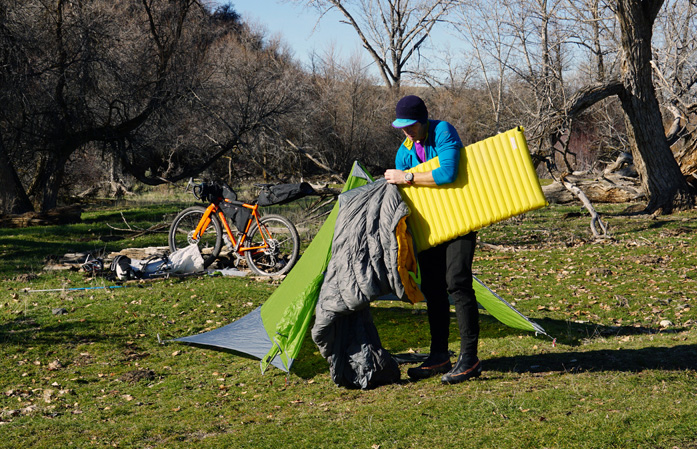
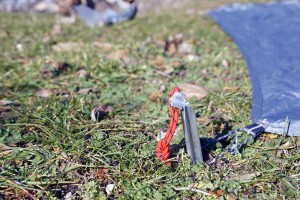 Billed for three, with a pole sitting dead center, the Apollo is better suited for two or one plus a bike.
Billed for three, with a pole sitting dead center, the Apollo is better suited for two or one plus a bike.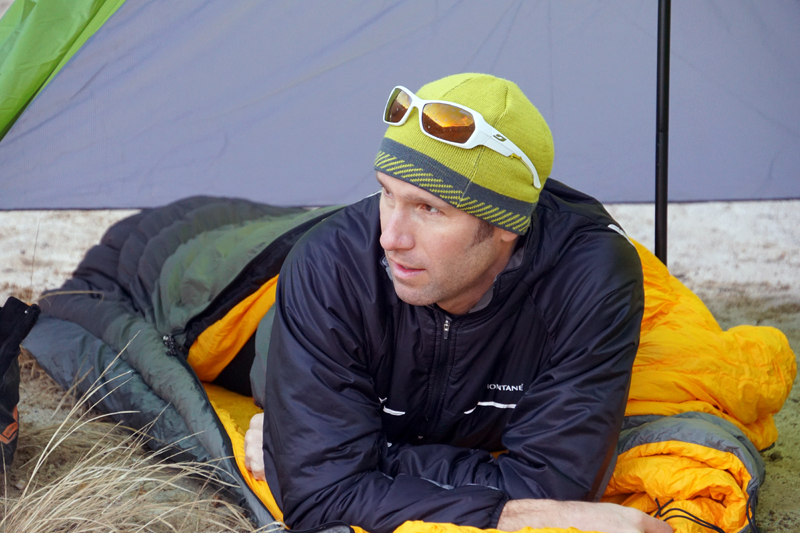
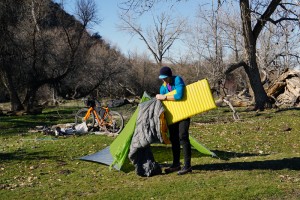
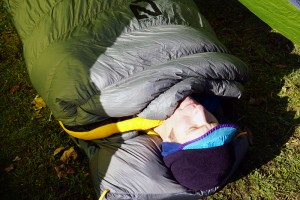 The hoodless design is intended to cut weight and volume. But more importantly, we think it provides better function. Hooded quilts with integrated pad sleeves can be a quirky match. The pad splays out the hood, creating draft tunnels around the head. For a mummy bag-like experience, we’d suggest buying a
The hoodless design is intended to cut weight and volume. But more importantly, we think it provides better function. Hooded quilts with integrated pad sleeves can be a quirky match. The pad splays out the hood, creating draft tunnels around the head. For a mummy bag-like experience, we’d suggest buying a 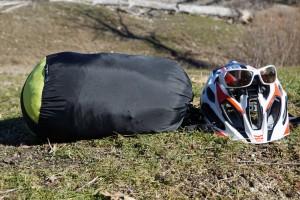 The medium fill quality (700 down) stuffs down to 5 liters. At 2 pounds 2 ounces, it’s still a fairly hefty bag that sacrifices compressibility. Perhaps not a big deal for ultralight hikers–where a bigger pack can carry more gear–space is a huge deal for bikepackers who stuff gear in limited sized frame and seat bags. That said, I was able to stuff both the Apollo tent and the Moonwalk sleeping bag into my
The medium fill quality (700 down) stuffs down to 5 liters. At 2 pounds 2 ounces, it’s still a fairly hefty bag that sacrifices compressibility. Perhaps not a big deal for ultralight hikers–where a bigger pack can carry more gear–space is a huge deal for bikepackers who stuff gear in limited sized frame and seat bags. That said, I was able to stuff both the Apollo tent and the Moonwalk sleeping bag into my 

 What We Liked: Unlike with a tent, buying a typical separate mesh liner to pair with a pyramid can be an expensive second purchase. Case in point: Black Diamond offers a two pound,
What We Liked: Unlike with a tent, buying a typical separate mesh liner to pair with a pyramid can be an expensive second purchase. Case in point: Black Diamond offers a two pound, 







